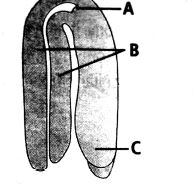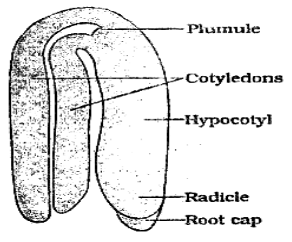Structure of a Dicot Embryo MCQ - Practice Questions with Answers
Quick Facts
-
8 Questions around this concept.
Solve by difficulty
Identify the different parts of typical dicot embryo labelled as A, B and C and select the correct option.
Consider the following statements w.r.t a dicot embryo:
a) Hypocotyl terminates with the stem tip and is called plumule.
b) Hypocotyl terminates with the root tip and is called radicle.
c) The part of embryonal axis above the level of cotyledons is called epicotyl.
d) The root tip is covered with a root cap.
The portion of the embryonal axis above the level of attachment of the scutellum is
Select the incorrect statement about external fertilisation:
The above structure is of ______?
Options:
Directions: In the following questions, a statement if Assertion (A) is followed by a statement of reason (R).
Assertion – The two cotyledons in seeds are embryonic leaves.
Reason – The embryo contains radicle & plumule.
Mark the correct choice as:
Concepts Covered - 0
- A typical dicotyledonous embryo consists of an embryonal axis and two cotyledons.
- The part of embryonal axis above the level of cotyledons is called epicotyl.
- It terminates with the stem tip, called plumule (future shoot).
- The part below the level of cotyledons is called hypocotyl which terminates in the root tip called radicle (future root).
- The root tip is covered with a root cap (calyptra).
- With the growth of an embryo, the ovule enlarges. Its integuments ultimately become hard to form protective coverings.
- Now the embryo undergoes rest and the ovule gets transformed into the seed.
"Stay in the loop. Receive exam news, study resources, and expert advice!"


